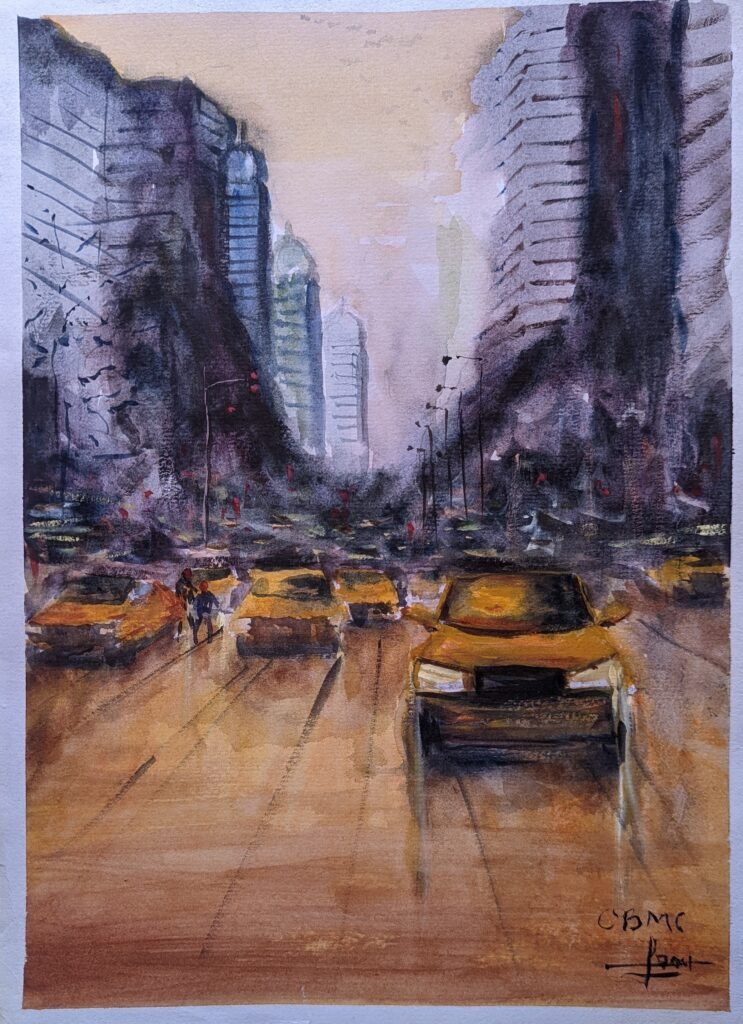
The watercolour painting, with its golden light, blurred yellow taxis, and towering, shadowy buildings, offers a visual whisper of Lagos. It is a snapshot, a single frame capturing the relentless energy that defines Nigeria’s most populous city. Yet, to truly understand the soul of Lagos, one must leave the two-dimensional canvas and plunge headfirst into the very heart of the “hustle and bustle” the artwork so subtly hints at. One must walk the teeming streets of Lagos Island, navigating the glorious chaos of Idumota, the human tidal wave at CMS, and the specialized commerce of Mandilas market.
Lagos Island is not just a geographical location; it is the commercial and historical epicentre of the city, a place where the past and present collide in a glorious, sometimes deafening symphony. Here, towering skyscrapers housing multinational corporations stand shoulder to shoulder with colonial-era buildings, their faded facades telling stories of a bygone era. It is a place of extremes, where high finance and street-level commerce coexist, and where millions of lives converge daily in a shared pursuit of ambition. The air here is thick with a unique mix of salt from the nearby Atlantic Ocean, the fragrant aroma of street food, and the distinct scent of exhaust fumes, a sensory overload that serves as an introduction to the island’s relentless pulse.
At the very heart of this pulse is the CMS (Cathedral Church of Christ) Bus Stop. The painting’s depiction of a road filled with yellow taxis pales in comparison to the reality of this transportation hub. CMS is a vortex, a confluence of human and vehicular traffic that operates with a logic all its own. From morning till night, the space is a frenetic ballet of yellow-and-black painted buses, known as “danfos,” their conductors hanging precariously out of the doors, shouting their destinations in a cacophony of voices. Here, thousands of commuters, traders, and visitors converge, each one a thread in the city’s vast, interwoven tapestry. The sheer volume of people, the honking of horns, the constant movement—it is a live performance of Lagos’s unyielding drive. It is a place where time is measured not in minutes, but in the number of buses you have to fight your way onto. The energy is infectious; it’s a living, breathing testament to the city’s spirit of “e go better,” the belief that tomorrow will be better, a belief that fuels the daily grind.
A short, but often arduous, walk from CMS leads to the sprawling labyrinth of Idumota Market. Idumota is not merely a market; it is an entire ecosystem of commerce, a multi-storied monument to Nigerian entrepreneurial spirit. It is a place where you can find everything from intricate bridal fabrics and traditional Yoruba attire to the latest electronics and household goods. The market is a maze of narrow alleyways and pathways, often just wide enough for a single person to squeeze through. The sheer density of human beings is breathtaking; you are part of a continuous flow, a river of people moving in all directions. The air is alive with the sounds of haggling, the calls of vendors advertising their wares, and the chatter of countless conversations. The sights are just as overwhelming: stalls piled high with colourful fabrics, vendors carrying impossibly large loads on their heads with effortless grace, and the glint of sunlight on countless goods. The energy here is aggressive yet vibrant, a reflection of the high-stakes nature of doing business in a place where one’s livelihood depends on a sharp wit and a quick transaction.
Tucked within this commercial behemoth is Mandilas, a name synonymous with car parts and accessories, but also representing a wider commercial ecosystem. The name itself is a historical marker, linked to the prominent Greek-Nigerian businessman J.M. Mandilas, whose company was once a major player in the automobile industry. Today, the Mandilas market area, like Idumota, is a bustling hive of specialized trade. Here, the hustle takes on a more specific form. You’ll find mechanics and traders expertly dissecting and selling everything from engine parts to electrical components. The atmosphere is one of focused expertise and rapid transaction, a testament to the city’s capacity for specialized commerce within a broader, chaotic whole. The energy here is a little less about the general din of a thousand traders and more about the hum of machines, the clinking of tools, and the rapid-fire conversations of experts in their craft.
The painting’s depiction of the “Street of Lagos” is a fitting visual bookend to this narrative of Lagos Island. Its blurred forms and energetic brushstrokes are not just artistic flourishes; they are a direct representation of the city’s ceaseless movement, its unyielding drive, and its beautiful, chaotic soul. The golden light that bathes the scene is a metaphor for the resilient optimism of Lagosians—a light that shines through the smog and the traffic. The “hustle and bustle” of Lagos Island, from the human tides of CMS to the labyrinthine markets of Idumota and Mandilas, is not just a feature of the city; it is its very essence. It is a relentless, exhausting, yet deeply inspiring energy that transforms a simple painting of a street into a profound and evocative portrait of a city and its people. This painting, in its quiet way, captures that spirit, inviting us to see beyond the canvas and hear the vibrant, deafening pulse of the city it represents.
0 Comments